The Hepatocellular Carcinoma HCC Treatment Market is estimated to be valued at USD 4.3 billion in 2025 and is projected to reach USD 33.8 billion by 2035, registering a compound annual growth rate (CAGR) of 22.9% over the forecast period.
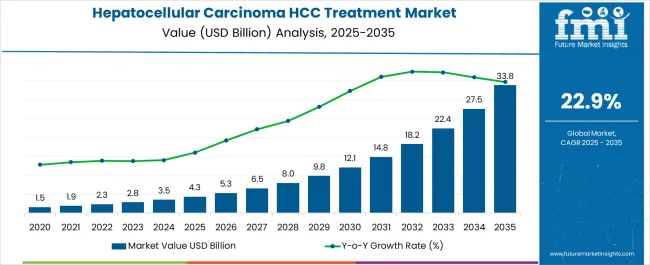
| Metric | Value |
|---|---|
| Hepatocellular Carcinoma HCC Treatment Market Estimated Value in (2025 E) | USD 4.3 billion |
| Hepatocellular Carcinoma HCC Treatment Market Forecast Value in (2035 F) | USD 33.8 billion |
| Forecast CAGR (2025 to 2035) | 22.9% |
The hepatocellular carcinoma treatment market is experiencing strong expansion, supported by the rising prevalence of liver cancer and the growing availability of advanced therapeutic options. Increasing incidence rates of hepatitis B, hepatitis C, and alcohol-related liver disease are contributing to a higher patient population requiring effective treatment. Significant investments in oncology research and the development of novel drug formulations are improving clinical outcomes, while government and institutional efforts to enhance cancer care infrastructure are further supporting market growth.
Advances in personalized medicine and biomarker-based therapies are enabling more targeted treatment approaches, reducing side effects and improving survival rates. The integration of combination therapies and continuous improvements in drug delivery technologies are expanding the scope of treatment.
As healthcare systems strengthen cancer screening and early diagnosis capabilities, the demand for hepatocellular carcinoma therapies is expected to accelerate With global pharmaceutical companies increasing their focus on oncology pipelines, the market is positioned to continue its robust growth trajectory across both developed and emerging regions.
The hepatocellular carcinoma hcc treatment market is segmented by application, end user type, and geographic regions. By application, hepatocellular carcinoma hcc treatment market is divided into Chemotherapy, Brachytherapy, and Local Ablation Therapy. In terms of end user type, hepatocellular carcinoma hcc treatment market is classified into Hospitals, Clinics, and Cancer rehabilitation centers. Regionally, the hepatocellular carcinoma hcc treatment industry is classified into North America, Latin America, Western Europe, Eastern Europe, Balkan & Baltic Countries, Russia & Belarus, Central Asia, East Asia, South Asia & Pacific, and the Middle East & Africa.
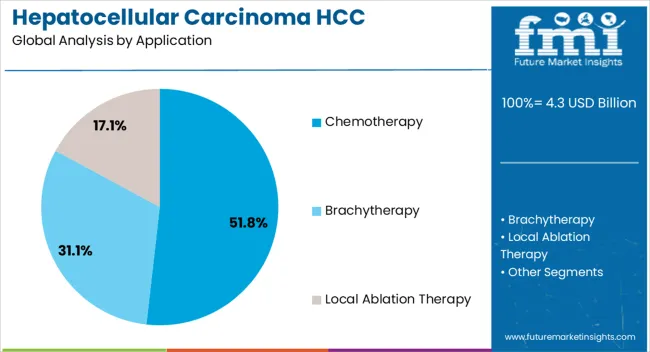
The chemotherapy segment is projected to account for 51.8% of the hepatocellular carcinoma treatment market revenue share in 2025, making it the leading application area. Its dominance is being reinforced by widespread clinical acceptance, broad availability, and relatively lower cost compared to newer targeted or immunotherapy options. Chemotherapy has long been a standard treatment for patients with advanced stages of hepatocellular carcinoma, where surgical interventions or localized therapies are not viable.
Its ability to reduce tumor size and slow disease progression has established it as a cornerstone of treatment regimens worldwide. The accessibility of chemotherapy drugs in both developed and developing markets supports its widespread use, particularly where advanced therapies may not be financially or logistically feasible.
Furthermore, ongoing research into optimizing dosage regimens, minimizing side effects, and combining chemotherapy with targeted or immunotherapies is strengthening its role in treatment strategies As the burden of hepatocellular carcinoma continues to rise, the sustained reliance on chemotherapy as a primary therapeutic approach is expected to secure its leading market position.
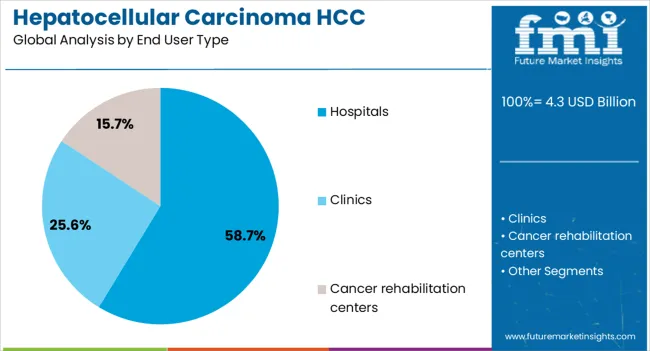
The hospitals segment is expected to represent 58.7% of the hepatocellular carcinoma treatment market revenue share in 2025, positioning it as the leading end user type. Its leadership is being driven by the availability of advanced oncology infrastructure, multidisciplinary treatment teams, and access to innovative drug therapies within hospital settings. Hospitals remain the primary point of care for cancer patients, where comprehensive diagnostic, surgical, and therapeutic services are provided under one roof.
The ability of hospitals to administer complex treatment regimens, including chemotherapy, immunotherapy, and targeted therapies, is a key factor contributing to their dominance. Increasing government and private sector investments in hospital infrastructure, coupled with a rising number of specialized cancer centers, are further enhancing treatment accessibility.
Hospitals also play a central role in clinical trials and research programs, accelerating the adoption of novel therapies As the prevalence of hepatocellular carcinoma continues to increase, hospitals are expected to maintain their leadership by serving as the primary hubs for advanced cancer treatment and patient management.
Hepatocellular carcinoma (HCC) is also known as malignant hepatoma. HCC is the major malignancy of the liver and is found to occur mainly in patients with chronic liver diseases and cirrhosis. The cells of origin of HCC are the hepatic stem cells, although this remains the subject of investigation.
The hepatic tumors proliferates with local expansion, spreading in intrahepatic region and finally distant metastases. The uncommon hepatocellular carcinoma is anticipated to witness rise in incidence rate during the forecast period. HCC is currently expected to be the third leading cause of death worldwide.
In the past, HCC generally occurred at an advanced stage of decompensated liver disease or cirrhosis. The technological advancements and the routine liver function tests are now resulting in the early detection of hepatocellular carcinoma. The increase in incidences of hepatocellular carcinoma associated with hepatitis C virus are expected to grow the hepatocellular carcinoma treatment market during the forecast period.
The incidence rate of hepatic cancer such as intrahepatic bile duct cancer in USA was approximately 39,230 during 2025. The risk factors associated with hepatocellular carcinoma are Hepatitis B virus (HBV) infection and hepatitis C virus (HCV) infection, alcoholic cirrhosis, metabolic syndrome, biliary cirrhosis, and chronic liver injury.
The advancement in technology, personalized medicine, cost effective treatment procedures are few other factors predicted to keep up the growth of global hepatocellular carcinoma treatment market.
However, side effects associated with the chemotherapy, high cost of treatment are some of the major restraints limiting the growth of global hepatocellular carcinoma treatment market.
Inventions in technologies for cancer treatment procedures are expected to launch into the market in the forecast period. Moreover, the increasing investment of pharmaceutical companies in the research and development of anticancer drugs would contribute to the growth of hepatocellular carcinoma treatment market.
Monoclonal antibodies and other immunological treatments are generally known for their lesser side effects and better efficacy.
Geographically, the global Hepatocellular Carcinoma (HCC) treatment market is classified into regions namely, North America, Latin America, Western Europe, Eastern Europe, APEJ, Japan, Middle East and Africa. Hepatitis B virus (HBV) infection and hepatitis C virus (HCV) infections are found to be the most significant cause of hepatocellular carcinoma.
Chronic HBV infection is the principal cause of hepatocellular carcinoma in Asia and Africa. HCV infection is the principal cause of hepatocellular carcinoma in North America, Europe, and Japan. The global hepatocellular carcinoma treatment market is expected to grow in future due to increasing investment by multinational companies in the cancer research.
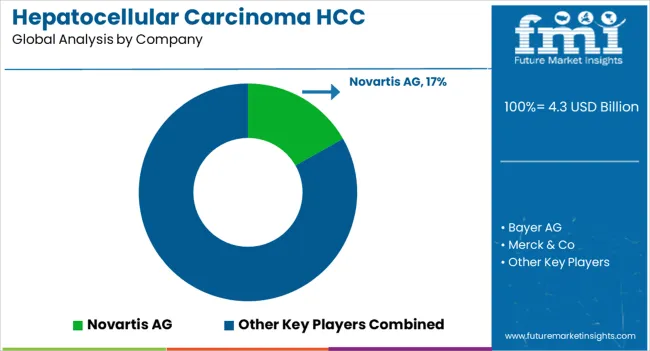
Bayer AG is one of the leading provider of hepatocellular carcinoma (HCC) treatment drugs. Some of the key players in hepatocellular carcinoma treatment market are Novartis Pharmaceuticals, Merck & Co., Inc., Bristol-Myers Squibb Company, AbbVie Inc., Johnson & Johnson Pvt. Ltd., Celgen Corporation, Amgen Inc., Teva pharmaceutical Industries Ltd., Pfizer Inc., and Takeda Pharmaceutical Co. Ltd. These companies focuses on the priority areas of the antiviral and oncology in order to address unmet medical needs.
The report is a compilation of first-hand information, qualitative and quantitative assessment by industry analysts, inputs from industry experts and industry participants across the value chain. The report provides in-depth analysis of parent market trends, macro-economic indicators and governing factors along with market attractiveness as per segments. The report also maps the qualitative impact of various market factors on market segments and geographies.
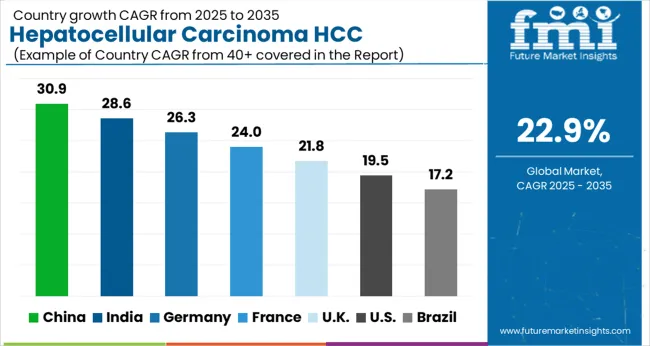
| Country | CAGR |
|---|---|
| China | 30.9% |
| India | 28.6% |
| Germany | 26.3% |
| France | 24.0% |
| UK | 21.8% |
| USA | 19.5% |
| Brazil | 17.2% |
The Hepatocellular Carcinoma HCC Treatment Market is expected to register a CAGR of 22.9% during the forecast period, exhibiting varied country level momentum. China leads with the highest CAGR of 30.9%, followed by India at 28.6%. Developed markets such as Germany, France, and the UK continue to expand steadily, while the USA is likely to grow at consistent rates. Brazil posts the lowest CAGR at 17.2%, yet still underscores a broadly positive trajectory for the global Hepatocellular Carcinoma HCC Treatment Market. In 2024, Germany held a dominant revenue in the Western Europe market and is expected to grow with a CAGR of 26.3%. The USA Hepatocellular Carcinoma HCC Treatment Market is estimated to be valued at USD 1.5 billion in 2025 and is anticipated to reach a valuation of USD 8.8 billion by 2035. Sales are projected to rise at a CAGR of 19.5% over the forecast period between 2025 and 2035. While Japan and South Korea markets are estimated to be valued at USD 209.1 million and USD 141.8 million respectively in 2025.
| Item | Value |
|---|---|
| Quantitative Units | USD 4.3 Billion |
| Application | Chemotherapy, Brachytherapy, and Local Ablation Therapy |
| End User Type | Hospitals, Clinics, and Cancer rehabilitation centers |
| Regions Covered | North America, Europe, Asia-Pacific, Latin America, Middle East & Africa |
| Country Covered | United States, Canada, Germany, France, United Kingdom, China, Japan, India, Brazil, South Africa |
| Key Companies Profiled | Novartis AG, Bayer AG, Merck & Co, Celgene Corporation, Bristol-Myers Squibb, Amgen Inc., Teva Pharmaceuticals Industries, AbbVie Inc., and Johnson & Johnson Services |
The global hepatocellular carcinoma hcc treatment market is estimated to be valued at USD 4.3 billion in 2025.
The market size for the hepatocellular carcinoma hcc treatment market is projected to reach USD 33.8 billion by 2035.
The hepatocellular carcinoma hcc treatment market is expected to grow at a 22.9% CAGR between 2025 and 2035.
The key product types in hepatocellular carcinoma hcc treatment market are chemotherapy, brachytherapy and local ablation therapy.
In terms of end user type, hospitals segment to command 58.7% share in the hepatocellular carcinoma hcc treatment market in 2025.






Our Research Products

The "Full Research Suite" delivers actionable market intel, deep dives on markets or technologies, so clients act faster, cut risk, and unlock growth.

The Leaderboard benchmarks and ranks top vendors, classifying them as Established Leaders, Leading Challengers, or Disruptors & Challengers.

Locates where complements amplify value and substitutes erode it, forecasting net impact by horizon

We deliver granular, decision-grade intel: market sizing, 5-year forecasts, pricing, adoption, usage, revenue, and operational KPIs—plus competitor tracking, regulation, and value chains—across 60 countries broadly.

Spot the shifts before they hit your P&L. We track inflection points, adoption curves, pricing moves, and ecosystem plays to show where demand is heading, why it is changing, and what to do next across high-growth markets and disruptive tech

Real-time reads of user behavior. We track shifting priorities, perceptions of today’s and next-gen services, and provider experience, then pace how fast tech moves from trial to adoption, blending buyer, consumer, and channel inputs with social signals (#WhySwitch, #UX).

Partner with our analyst team to build a custom report designed around your business priorities. From analysing market trends to assessing competitors or crafting bespoke datasets, we tailor insights to your needs.
Supplier Intelligence
Discovery & Profiling
Capacity & Footprint
Performance & Risk
Compliance & Governance
Commercial Readiness
Who Supplies Whom
Scorecards & Shortlists
Playbooks & Docs
Category Intelligence
Definition & Scope
Demand & Use Cases
Cost Drivers
Market Structure
Supply Chain Map
Trade & Policy
Operating Norms
Deliverables
Buyer Intelligence
Account Basics
Spend & Scope
Procurement Model
Vendor Requirements
Terms & Policies
Entry Strategy
Pain Points & Triggers
Outputs
Pricing Analysis
Benchmarks
Trends
Should-Cost
Indexation
Landed Cost
Commercial Terms
Deliverables
Brand Analysis
Positioning & Value Prop
Share & Presence
Customer Evidence
Go-to-Market
Digital & Reputation
Compliance & Trust
KPIs & Gaps
Outputs
Full Research Suite comprises of:
Market outlook & trends analysis
Interviews & case studies
Strategic recommendations
Vendor profiles & capabilities analysis
5-year forecasts
8 regions and 60+ country-level data splits
Market segment data splits
12 months of continuous data updates
DELIVERED AS:
PDF EXCEL ONLINE
Merkel Cell Carcinoma Treatment Market
Neuroendocrine Carcinoma Treatment Market Size and Share Forecast Outlook 2025 to 2035
Nasopharyngeal Carcinoma Treatment Market Size and Share Forecast Outlook 2025 to 2035
Unresectable Hepatocellular Carcinoma Market - Growth & Outlook 2025 to 2035
Treatment-Resistant Hypertension Management Market Size and Share Forecast Outlook 2025 to 2035
Treatment-Resistant Depression Treatment Market Size and Share Forecast Outlook 2025 to 2035
Treatment Pumps Market Insights Growth & Demand Forecast 2025 to 2035
Pretreatment Coatings Market Size and Share Forecast Outlook 2025 to 2035
Air Treatment Ozone Generator Market Size and Share Forecast Outlook 2025 to 2035
CNS Treatment and Therapy Market Insights - Trends & Growth Forecast 2025 to 2035
Seed Treatment Materials Market Size and Share Forecast Outlook 2025 to 2035
Acne Treatment Solutions Market Size and Share Forecast Outlook 2025 to 2035
Scar Treatment Market Overview - Growth & Demand Forecast 2025 to 2035
Soil Treatment Chemicals Market
Water Treatment System Market Size and Share Forecast Outlook 2025 to 2035
Water Treatment Chemical Market Size and Share Forecast Outlook 2025 to 2035
Algae Treatment Chemical Market Forecast and Outlook 2025 to 2035
Water Treatment Market Size and Share Forecast Outlook 2025 to 2035
Water Treatment Ozone Generator Market Size and Share Forecast Outlook 2025 to 2035
Water Treatment Equipment Market Size and Share Forecast Outlook 2025 to 2035

Thank you!
You will receive an email from our Business Development Manager. Please be sure to check your SPAM/JUNK folder too.
Chat With
MaRIA